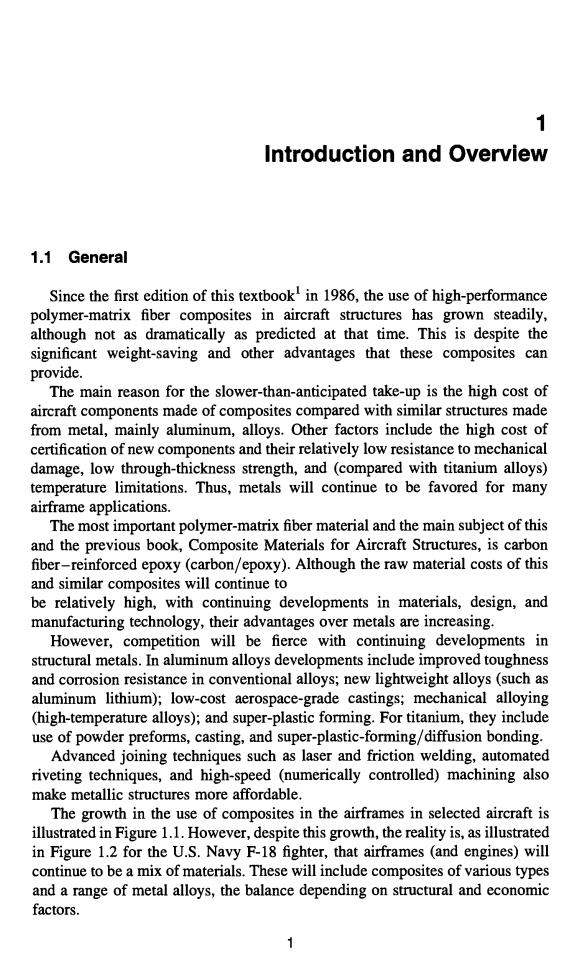正在加载图片...

1 Introduction and Overview 1.1 General Since the first edition of this textbook'in 1986,the use of high-performance polymer-matrix fiber composites in aircraft structures has grown steadily, although not as dramatically as predicted at that time.This is despite the significant weight-saving and other advantages that these composites can provide. The main reason for the slower-than-anticipated take-up is the high cost of aircraft components made of composites compared with similar structures made from metal,mainly aluminum,alloys.Other factors include the high cost of certification of new components and their relatively low resistance to mechanical damage,low through-thickness strength,and (compared with titanium alloys) temperature limitations.Thus,metals will continue to be favored for many airframe applications. The most important polymer-matrix fiber material and the main subject of this and the previous book,Composite Materials for Aircraft Structures,is carbon fiber-reinforced epoxy(carbon/epoxy).Although the raw material costs of this and similar composites will continue to be relatively high,with continuing developments in materials,design,and manufacturing technology,their advantages over metals are increasing. However,competition will be fierce with continuing developments in structural metals.In aluminum alloys developments include improved toughness and corrosion resistance in conventional alloys;new lightweight alloys(such as aluminum lithium);low-cost aerospace-grade castings;mechanical alloying (high-temperature alloys);and super-plastic forming.For titanium,they include use of powder preforms,casting,and super-plastic-forming/diffusion bonding. Advanced joining techniques such as laser and friction welding,automated riveting techniques,and high-speed (numerically controlled)machining also make metallic structures more affordable. The growth in the use of composites in the airframes in selected aircraft is illustrated in Figure 1.1.However,despite this growth,the reality is,as illustrated in Figure 1.2 for the U.S.Navy F-18 fighter,that airframes (and engines)will continue to be a mix of materials.These will include composites of various types and a range of metal alloys,the balance depending on structural and economic factors.1 Introduction and Overview 1.1 General Since the first edition of this textbook 1 in 1986, the use of high-performance polymer-matrix fiber composites in aircraft structures has grown steadily, although not as dramatically as predicted at that time. This is despite the significant weight-saving and other advantages that these composites can provide. The main reason for the slower-than-anticipated take-up is the high cost of aircraft components made of composites compared with similar structures made from metal, mainly aluminum, alloys. Other factors include the high cost of certification of new components and their relatively low resistance to mechanical damage, low through-thickness strength, and (compared with titanium alloys) temperature limitations. Thus, metals will continue to be favored for many airframe applications. The most important polymer-matrix fiber material and the main subject of this and the previous book, Composite Materials for Aircraft Structures, is carbon fiber-reinforced epoxy (carbon/epoxy). Although the raw material costs of this and similar composites will continue to be relatively high, with continuing developments in materials, design, and manufacturing technology, their advantages over metals are increasing. However, competition will be fierce with continuing developments in structural metals. In aluminum alloys developments include improved toughness and corrosion resistance in conventional alloys; new lightweight alloys (such as aluminum lithium); low-cost aerospace-grade castings; mechanical alloying (high-temperature alloys); and super-plastic forming. For titanium, they include use of powder preforms, casting, and super-plastic-forming/diffusion bonding. Advanced joining techniques such as laser and friction welding, automated riveting techniques, and high-speed (numerically controlled) machining also make metallic structures more affordable. The growth in the use of composites in the airframes in selected aircraft is illustrated in Figure 1.1. However, despite this growth, the reality is, as illustrated in Figure 1.2 for the U.S. Navy F-18 fighter, that airframes (and engines) will continue to be a mix of materials. These will include composites of various types and a range of metal alloys, the balance depending on structural and economic factors